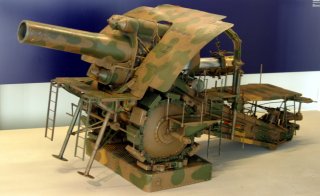World War I: New Weapons, Same Old (Bad) Tactics
Which were the deadliest weapons of World War I? There are so many choices. Here are five.
Here's What You Need To Remember: None of these weapons was brand-new; several had already been used in colonial wars. But World War I was the first time that both sides had them. The results were devastating.
Editor’s Note: Please also take a look at other World War I TNI articles including: How Germany Could Have Won World War I, World War I: Five Ways Germany Could Have Won the First Battle of the Atlantic, and World War I’s Empire of the “Living Dead”: Austria-Hungary.
Today we take granted that warfare is mechanized, electronicized, a form of human activity where humans are the least important component.
But it didn't seem that way in 1914. Europeans sleepwalked into war dreaming of cavalry charges and massed infantry charges with fixed bayonets. They awoke to confront the machine gun and the U-boat, the tank and the airplane.
Which were the deadliest weapons of World War I? There are so many choices. Here are five:
Maxim MG 08 Machine Gun:
"Whatever happens we have got, the Maxim gun and they have not," ran Hilaire Belloc's verse describing machine gun-equipped European troops battling a native revolt. But that smugness quickly disappeared when Europeans turned those machine guns on each other in World War I.
The enduring image of World War I is the machine gun, and usually a German machine gun. It's easy to see why. The Germans armed their troops with machine guns far more lavishly than their opponents. And because they were mostly on the defensive in the West after 1914, they could emplace their machine guns in fortified positions and then mow down advancing Allied soldiers.
The MG 08 was the standard German machine gun. A copy of Hiram Maxim's design from 1894, it was a clumsy weapon by modern standards. The early war version weighed 60 pounds for the machine gun alone, plus nearly a hundred pounds for the carriage and accessories. Even mounted on a handier tripod later in the war, it wasn't exactly a mobile weapon.
But it could reliably spray out 500 rounds a minute, which cut down massed Allied infantry assaults like a scythe. It was still in use 50 years later in the Communist Chinese and North Korean armies.
Mark V tank:
Every weapon has a counter-weapon. The machine gun's nemesis was the tank. Entrenched machine guns could survive weeks of massive artillery bombardment at muddy hells like Passchendaele. But a tracked vehicle, well-armored enough to survive machine gun fire and powerful enough to knock down barbed wire, could breach a path for attacking infantry to cross No Man's Land without being cut to pieces.
The 29-ton British Mark V was the heaviest British tank of the war. It may have resembled a paper clip on treads, but its long, wide shape was better at crossing trenches than more elegantly designed modern tanks. Its roughly half-inch armor was thick enough to deflect bullets, and armed with either 57-millimeter cannon (the "male" version") or just .303-caliber machine guns (the "female" version), it could destroy machine gun nests and pillboxes.
These first tanks were hot, noisy and unreliable. Operating them must have been like sitting in the middle of a steam engine. They were also vulnerable to German artillery firing directly over open sights. Nonetheless, they were powerful enough to help end the bloody trench stalemate of World War I.
Fokker Triplane:
Baron von Richtofen flew it and Snoopy battled it. Could there be higher testimonials to the lethality of the Fokker Dr 1 triplane? By today's standards, a hundred mile-per-hour top speed is laughable, even compared to a Cessna 172. Actually, it was slow compared to Allied fighters like the Sopwith Triplane and Spad VIII.
But blessed with extreme maneuverability and a rapid climb rate, and in the hands of an airborne killer like the Red Baron and his "Flying Circus," the triple-winged Fokker terrorized the skies over the Western Front in 1917-18.
Type 93 U-boat:
The U-boat is another enduring image of the First World War, which marked the advent of undersea as well as aerial and mechanized warfare. One deadly German design was the Type 93 U-boat.
Fast they were not, sailing underwater at a torpid pace of 9 knots, and 17 knots on the surface. Endurance in those days was limited (the earliest World War I U-boats could only stay underwater an hour before the batteries ran out). But armed with an 88- or 105-millimeter deck guns and six torpedo tubes with 16 reloads, the 24 Type 93s built by Germany sank 411,000 tons of Allied shipping.
Big Bertha and the Paris Gun:
Deadly weapons or freaks of gunpowder? You decide.
Big Bertha was a giant German howitzer with a caliber of 16.5 inches, wider than most battleship guns at the time. Hurling a nearly one-ton shell as far as eight miles away, Big Bertha smashed Belgian forts in 1914, allowing the German armies to pass through Belgium and almost capture Paris.
The Paris Gun made history by hurling shells into the stratosphere. Where Big Bertha was squat, the Paris Gun was long and narrow, firing a 200-pound shell as far as 81 miles away, which allowed the Germans to conduct a long-range bombardment of Paris.
Like all such wonder weapons, they were expensive and fragile (the Paris Gun could only fire 20 shells before the barrel wore out). But being able to destroy forts or bombard a city from nearly a hundred miles away earned them their notoriety.
Michael Peck is a contributing writer at Foreign Policy and a writer for War is Boring. Follow him on Twitter:@Mipeck1. This first appeared in August 2014.
Image: Pinterest.

